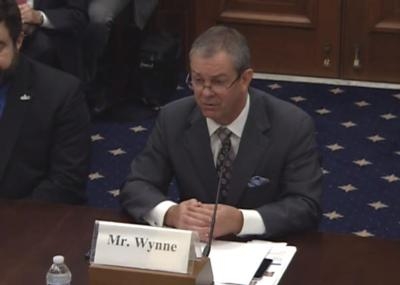Witnesses Included AUVSI President Brian Wynne
The House Transportation and Infrastructure Committee’s Aviation Subcommittee held a hearing Wednesday to consider technological, legal, and policy issues related to the use and integration of unmanned aircraft systems (UAS) in the national airspace system.

"We are ... the world leader in innovation, and one sector I want to see thrive is the use of unmanned aerial systems. UAS are the latest intersection of aviation and innovation and I am excited to see where this industry goes from here," said Committee Chair Bill Shuster (R-PA) in his opening statement (pictured).
"UAS have emerged as a strong growth sector in the aviation industry and are providing good-paying jobs here in the United States.
"As their numbers grow, more and more promising applications for UAS are being realized and planned. UAS have a variety of uses, ranging from assisting farmers survey crops and croplands to visual inspections of aircraft, roads, railroads, pipelines, and bridges.
Shuster said that during the historic hurricane season we had this year, UAS played an important role in relief and recovery efforts. UAS were used as airborne cell phone towers to ensure continued phone service and Wi-Fi internet access after these natural disasters. Without this technology, many survivors of the hurricanes would have been cut off from their families. UAS were used to survey damage from the storms, allowing for faster recovery efforts.
"The sheer volume of UAS now operating in the National Airspace System—about two million have been sold in the United States to date—and their unique features are causing policy-makers and operators to rethink all aspects of airspace use," said Subcommittee chair Frank LoBiondo (pictured).

"Until recently, we thought of “aircraft” as mainly flying miles above us carrying people and cargo between airports with runways. UAS, on the other hand, can take off and land literally anywhere. They fly a few hundred feet above the ground and easily operate around buildings, factories, utility lines, and farm fields.
"The possibilities are exciting: our power companies can evaluate damage quickly after a storm while keeping people out of harm’s way. Farmers can more efficiently assess their crops. All kinds of equipment and buildings can be inspected faster and safer than ever before. Drones are changing the way first responders conduct search and rescue operations and how they monitor disasters and recovery activities.
"In other countries, companies are beginning to use drones to deliver goods either directly or in combination with delivery vans. For example, Mercedes Benz is using drones in Switzerland to deliver items such as ground coffee and cell phones in Switzerland on a trial basis.
"These examples make clear how important it is to maintain American leadership in aviation. We cannot rest on our laurels; the benefits of technological advancement and the costs of complacency are too great. As such we must continue to diligently move forward with UAS integration," LoBiondo said.

During his testimony, AUVSI president and CEO Brian Wynne (pictured) said the United States is at the dawn of a new American renaissance in technology, one that deserves continued government attention and support. In the past, government invested heavily in physical infrastructure – from the nation’s air traffic control system to its interstate highway system and the internet – which ultimately had a tremendous impact on commerce. The benefits, however, did not stop there. Over time, the safety, security and efficiency gains we achieved as a nation have vastly outweighed the costs, and the unmanned systems industry will be no different.
"Facilitating interstate commerce is the responsibility of the federal government, but government investments in infrastructure didn’t originate solely from a sense of obligation; it came from necessity coupled with vision and an embrace of what’s possible. Technology is advancing at lightning speed, especially in the realm of UAS. The promise of UAS is not held back by innovation, imagination or technology, but by a lack of regulatory clarity," Wynne said.
"We need a new national imperative in unmanned systems that, like the air traffic control system and interstate highway system before it, creates greater capacity, fulfills consumer demand and facilitates the future of commerce. Industry is bringing the technology; government needs to do more to support it and advance innovations."
Wynne called on Congress to adequately fund the FAA so it can meet the employment and staffing needs required for the future, including the federal rulemaking processes for UAS integration. "Equally as important is additional federal investment to update the FAA’s information technology infrastructure. This will allow the agency to automate its UAS processes in collaboration with industry to meet the growing demand for UAS services and enhance the safety and security of the national airspace," he said.
"Congress and the FAA must also engage state and local governments in conversations regarding UAS regulations. Maintaining federal sovereignty of the airspace keeps our skies safe and helps foster innovation, but soliciting input from non-federal bodies such as states, municipalities and tribal governments will be integral to moving federal regulations forward. The White House’s recent announcement of a UAS Integration Pilot Program is a positive step in that direction. It represents an opportunity for these state and local governments to collaborate with the UAS industry and the FAA to further develop a federal policy framework for integrating UAS into the skies above communities across the nation."
(Source: House Transportation Committee and AUVSI news releases. Images from file)
 ANN's Daily Aero-Linx (04.16.24)
ANN's Daily Aero-Linx (04.16.24) Aero-News: Quote of the Day (04.16.24)
Aero-News: Quote of the Day (04.16.24) Airborne 04.10.24: SnF24!, A50 Heritage Reveal, HeliCycle!, Montaer MC-01
Airborne 04.10.24: SnF24!, A50 Heritage Reveal, HeliCycle!, Montaer MC-01 Airborne 04.12.24: SnF24!, G100UL Is Here, Holy Micro, Plane Tags
Airborne 04.12.24: SnF24!, G100UL Is Here, Holy Micro, Plane Tags Airborne-Flight Training 04.17.24: Feds Need Controllers, Spirit Delay, Redbird
Airborne-Flight Training 04.17.24: Feds Need Controllers, Spirit Delay, Redbird





